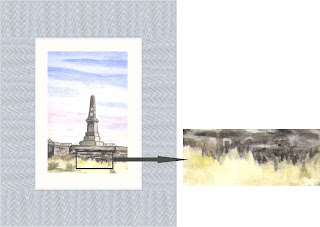
When using acrylic paint you can add layers of light colour to increase the definition of a pale area. However another option is to paint in the negative area to highlight the pale area.
This is a very good technique and can make your paintings more interesting. It is also an easy way to add detail to a flat area of colour.
The example is just a small section of a painting but it shows how this simple technique can quickly add interest with the minimum effort!
In this example
Always try to contrast light and dark areas in a picture. When you have this kind of contrast it is easy to paint in some of the negative areas because one of the adjoining sections will be in a darker colour.
(I think that it is more successful to paint in negative areas with a darker colour, but if you want to try to use a lighter colour over a darker one be sure to use the paint more thickly.)
In this case the dark colour is used to make the top of the pale area jagged; this makes the pale area look more grass like.
In the example the darker colour was used to paint in the negative area behind the grasses and then faded into the background area. The unevenness of the stone wall made this easy, but if the negative area was smooth you can just blend the colour using water to thin it. By leaving a darker edge next to the pale colour you get a nice contrast too.
Use this technique
To add definition to any areas you feel needs it. It would be good for darkening the area to the side of a tree trunk and make the trunk stand out a bit more. Ideal for the trunk of a silver birch, just add some extra dark shades to the area at the side of the trunk to give the trunk more contrast and this helps to make the trunk more three dimensional too.
It is great for forest paintings as you can hint at more trees in the background without giving them too much detail.
Top Tip – the greatest contrast areas are always in the foreground of a picture. Make sure you have the contrast between the colours suitable for the distance in the painting, i.e. not too much contrast for areas in the distance.
Visit the Learn and Do website at http://www.learnanddo.com/ to find out more about The Acrylic Painting Course. Check out the free preview of the course too.
No comments:
Post a Comment